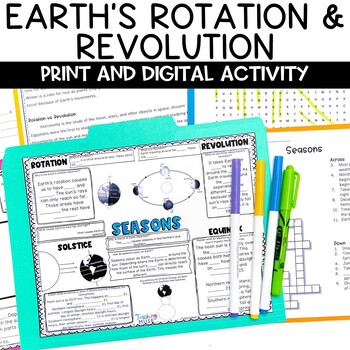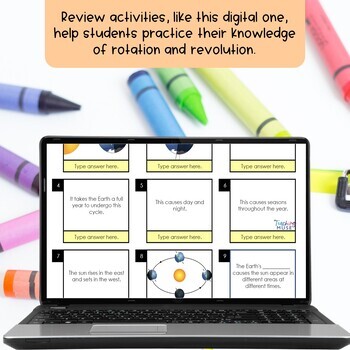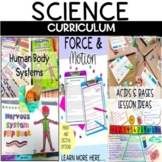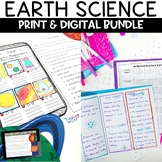Earth Rotation Revolution Seasons NGSS Activity
- PDF
- Google Apps™

What educators are saying
Also included in
- Looking for a science curriculum to last all school year that will help you teach your physical science, life science, Earth science, and chemistry units? Check out everything this science curriculum has to offer. This year-long science curriculum includes science texts, hands-on activities, classroPrice $326.71Original Price $363.01Save $36.30
- Do you need ways to engage your earth science students on the topics of lunar phases, stars, galaxies, solar system, Earth's layers, Earth's rotation and revolution, tides, eclipses, weathering, erosion, rocks, and minerals? This bundle of earth science curriculum lessons offers a variety of learninPrice $45.00Original Price $63.99Save $18.99
Description
Teach your students how Earth's rotation and revolution cause day, night, and seasons using ideas to introduce earth's seasons through phenomena, a teacher presentation on rotation, revolution, seasons, solstices, and equinoxes, student fill-in notes, science text, graphic organizer, and review activities aligned to NGSS standards.
Like this activity on earth's rotation and revolution? Check out the bundle here and save over 20%.
Students will be able to:
- Identify what rotation is
- Describe how the Earth rotates
- Explain why we have day and night
- Identify what revolution is
- Describe how the Earth revolves around the sun
- Explain why we have seasons
- Tell the difference between a solstice and an equinox
This lesson on seasons includes:
- Teacher tips pages: including how to use the lesson and activities, NGSS alignment and simulations, and ideas to extend student knowledge of seasons. There are also tips for using the digital portions of this activity.
- Teacher presentation: Use with your students to introduce seasons, the earth's rotation, the earth's revolution, solstice, and equinox
- Student fill-in note sheet: Students will fill in notes that follow the teacher's presentation.
- 5 page reading on Earth's rotation and revolution - includes comprehension questions.
- 11 Google slides on Earth's rotation and revolution - includes comprehension questions.
- 2 graphic organizers: Scaffolded and blank versions allow you to differentiate in your classroom.
- Reinforces concepts related to rotation, revolution, day, night, and seasons
- Allows students to create their model of Earth, sun, and moon
- Digital Google Sheet activity to show understanding of rotation and revolution.
- Digital mystery picture activity to review Earth's movements
- Crossword puzzle
- Word search
- Answer key
This rotation and revolution lesson is aligned to NGSS MS-ESS1-1: Develop and use a model of the Earth-sun-moon system to describe the cyclic patterns of lunar phases, eclipses of the sun and moon, and seasons.
How to use this activity in your classroom:
- Teacher presentation: Introduce seasons, day / night, revolution, rotation, equinox, and solstices
- Fill in Notes: Students fill this in during class and then have them in their notebook to reference throughout the unit.
- Student text: Great for struggling learners who need more support in the classroom. Students can read this in small groups or independently. It's great for homework assignments or sub plans.
- Graphic organizer: Students can either use their fill-in notes or the student text to look back and fill in the requested information.
- Review activities: Whether you decide to use them as homework, fast finisher assignments, sub plans, or classwork, these activities will help students to reinforce and review their learning. Encourage students to look back at their notes, science text, or graphic organizer if they need help.
Feedback from teachers:
- We used this as notes in their interactive journals. It made the notes more "fun," and the students enjoyed it. GREAT resource that I plan to use each year.
- My class really enjoyed doing this activity to aid in their understanding of the earth rotations.
- Thank you for these engaging notes and the choice of how to use them. They were engaging and great study material!
- My students loved this! It was exactly what I needed to help my students understand the seasons.
- Thank you for sharing. My students enjoyed this activity to help with the concepts we covered with rotation and revolution in social studies.
Other earth science lessons and activities you might be interested in:
- Tides and Eclipses
- Moon and Lunar Phases Unit
- Rocks and Minerals Unit
- Weathering and Erosion
- Characteristics and Life Cycle of a Star
Kindly Note: If you have questions, do not hesitate to email me at Teaching Muse Email
PLEASE PREVIEW BEFORE PURCHASING
__________________________________________________________________
Thank you for visiting Teaching Muse. I would love for you to become a follower.
Teaching Muse followers receive new product information and discounts on any new items!
__________________________________________________________________
All rights reserved by Teaching Muse. This product is to be used by the original downloader ONLY. Copying for more than one teacher, classroom, department, school, or school system is prohibited. Additionally, this product may not be distributed or displayed digitally for public view. Failure to comply is a copyright infringement and violates the Digital Millennium Copyright Act (DMCA). They are intended for classroom and personal use ONLY.







